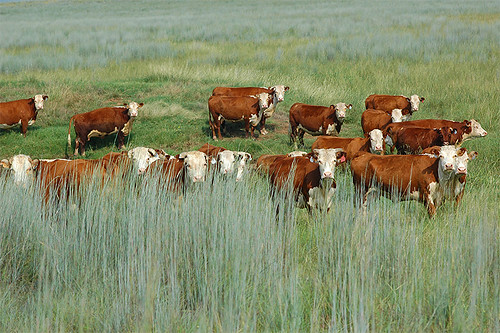
James K. “Rooter” Brite, Jr. is a born-to-the-land Texas rancher and participant in USDA’s Natural Resources Conservation Service (NRCS) conservation programs.
Brite was born and raised on the ranch his grandfather, J.A. Brite, purchased in 1929, near Bowie, Texas. These days he runs more than 850 cows and yearlings on 3,400 acres of shallow, rocky soils, tall grass prairie and post oak cross timber in an area that receives less than 30 inches of rainfall annually.
As part of the conservation plan NRCS helped Brite put together for his operation, he has installed fencing to create new pastures and implement a rotational grazing system where cows are moved between pastures to improve the health of the soil and forage. He installed watering facilities so cattle have access to water in all of the pastures. He also removed undesirable plants, began prescribed burning for ecosystem health and improved areas on the ranch for wildlife habitat.
All of these are best practices that NRCS has created through its work with the Grazing Lands Conservation Initiative (GLCI), and will be highlighted at the group’s upcoming 5th National Conference on Grazing Lands, Dec. 9-12 in Orlando, Florida.
Brite is especially well placed to know what he is doing as a conservation-minded rancher, because in his free time he represents the National Association of Conservation Districts on the GLCI Steering Committee and is a member and past president of the Texas GLCI Coalition.

GLCI is a nationwide consortium of individuals and organizations working together to maintain and improve the management and health of America’s grazing lands. NRCS, which has worked closely with Brite to help him put conservation on the land, is also represented on the GLCI Advisory Committee.
Bob Drake, GLCI chairman, says that this conference is different from others: besides the usual experts from the academic, government and nonprofit worlds, he says, “We also look for the ‘cowboy expert’ who has gained his or her expertise through long hours with livestock and first-hand exposure to all sorts of elements—natural, economic and political.”
Conference participants will also have the opportunity to learn from many producer/rancher presenters and featured speakers, including Temple Grandin, noted animal behavior expert, author, speaker and Colorado State University professor and Fred Provenza, Utah State University professor, award-winning research scientist and rancher.
Brite says that GLCI helps ranchers with the long view.
“You have to look at the cumulative value of everything you do on the land,” Brite says. “Management decisions you make now will make a difference 30 years from now. It all adds up.”
Follow NRCS on Twitter.
Check out other conservation-related stories on the USDA blog.
